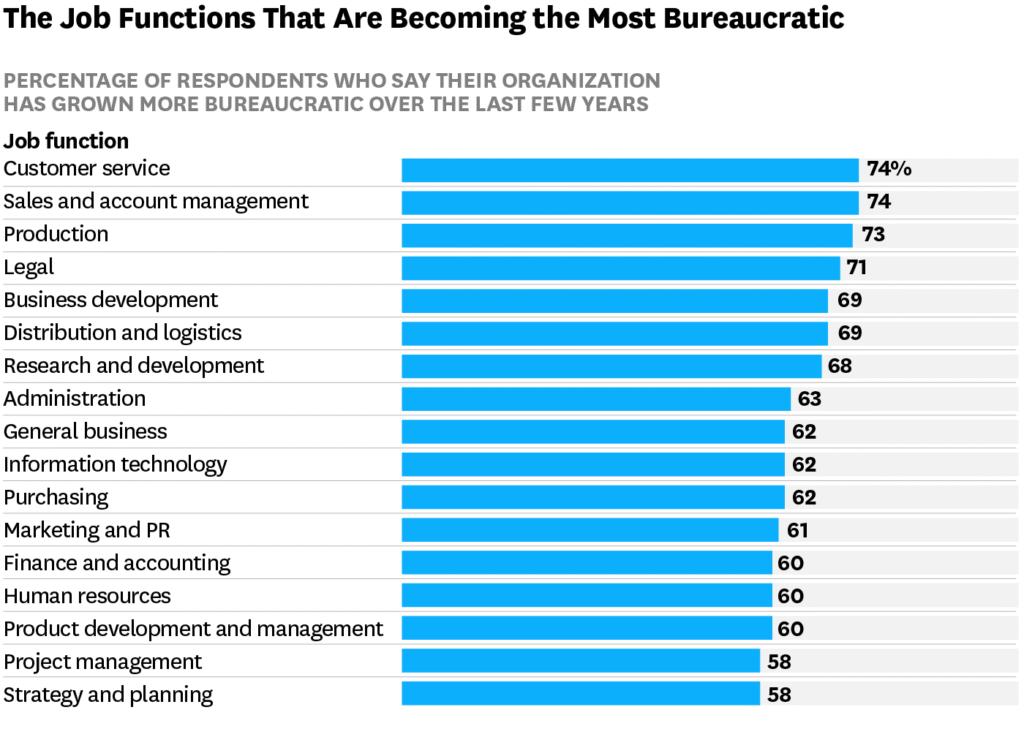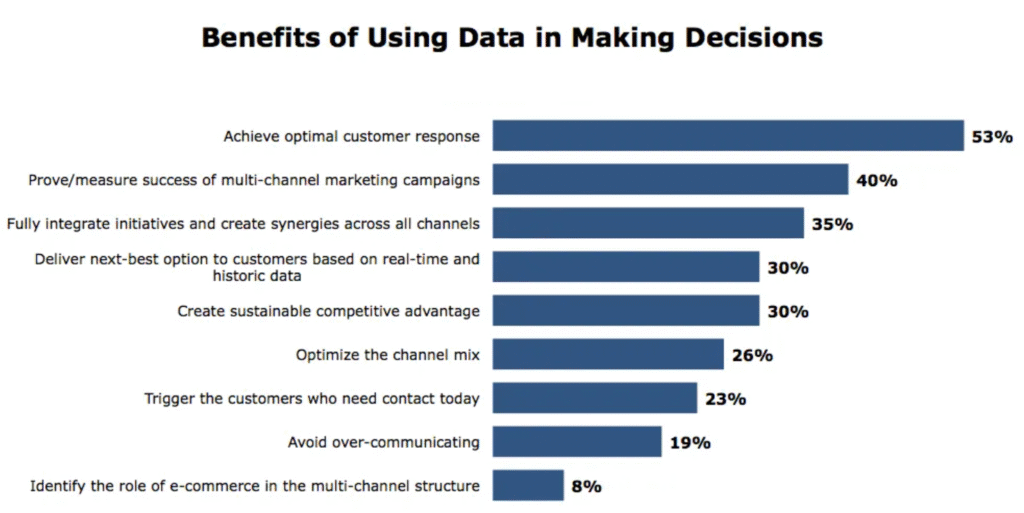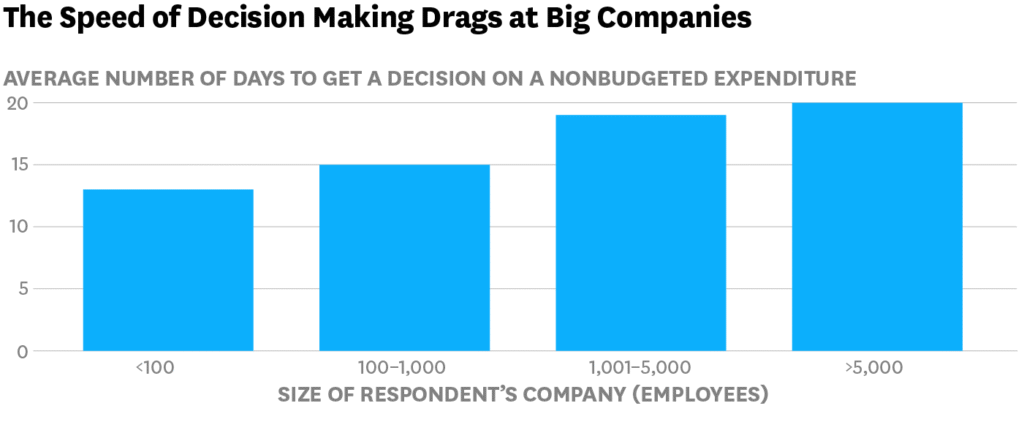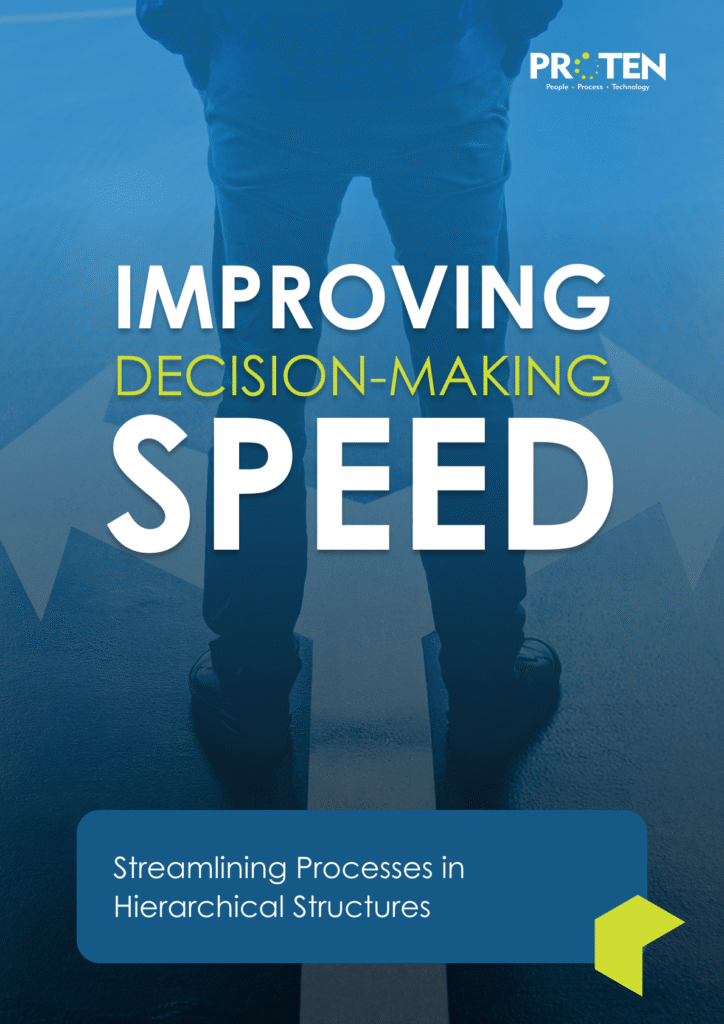According to a 2023 study by PwC, 68% of Nigerian businesses report delays in decision-making due to excessive layers of approval, with 45% citing bureaucratic inertia as a key barrier to operational efficiency. These delays impact competitiveness, especially in fast-paced industries like technology, finance, and manufacturing.

Source: HBR
The private sector is often characterised by a top-down corporate culture that slows decision-making and hampers process efficiency. Hierarchical structures, while ensuring control and accountability, usually lead to bureaucratic delays that stifle innovation and agility. This scenario analysis explores strategies to streamline decision-making processes within Nigeria’s private sector, focusing on delegation, digital tools, and training for mid-level managers. Three scenarios—best case, worst case, and moderate case—are evaluated to assess potential outcomes.
Scenarios
Best Case: Delegated Authority and Digital Dashboards Halve Decision Times
In this scenario, companies adopt a decentralised decision-making model, empowering mid-level managers with the authority to make routine and tactical decisions. Digital dashboards provide real-time data on key performance indicators (KPIs), enabling faster, data-driven decisions. Training programmes equip managers with skills to leverage these tools effectively, reducing reliance on top-level approvals. Organisational hierarchies are flattened incrementally, fostering a culture of agility and accountability.

Source: Teradata
Using this model, a Nigerian fintech company implemented a decentralised structure with real-time dashboards, cutting loan approval times from 7 days to 3 days, and increasing customer satisfaction by 25%.
Outcomes:
- Decision-Making Speed: Delegating distributes tasks across a team, preventing one person from carrying the entire workload. This leads to faster completion, as progress isn’t limited by a single individual’s time or capabilities.
- Efficiency Gains: Each team member brings unique strengths and skills to the table. By delegating tasks to those best equipped for them, you ensure the work is handled more effectively, resulting in higher-quality outcomes.
- Employee Engagement: Effective delegation demonstrates trust in your team’s abilities, which boosts their confidence and morale. It empowers them to take pride in their work while also providing opportunities to grow their skills and take on greater responsibilities.
Worst Case: Bureaucratic Inertia Triples Delays
In this scenario, companies fail to address bureaucratic hurdles, and hierarchical structures become more entrenched. Decision-making remains centralised, with multiple approval layers causing significant delays. Lack of investment in digital tools and training exacerbates inefficiencies, as staff rely on manual processes and outdated systems. Bureaucratic inertia stifles innovation, leading to missed market opportunities.

Source: HBR
Outcomes:
- Slow Decision-Making: One of the key weaknesses of bureaucratic systems is their slow decision-making. The process often involves numerous consultations, assessments, and negotiations, resulting in delays. These setbacks are largely due to multiple approval layers and strict adherence to cumbersome procedures.
- Efficiency Losses: Bureaucracies often struggle to adapt quickly to changing circumstances or unexpected events due to their rigid hierarchies and fixed procedures. This inflexibility makes it challenging to respond promptly and effectively when situations demand swift action. Data shows that rigid multinational corporations experience project delay increase by 40%, with cost overruns of 15–20%.
- Employee Frustration: Repetitive routines can become unsustainable without a clear sense of purpose or direction. In bureaucracies, emphasis is often placed on how tasks are completed rather than the quality of the outcomes. This can lower morale, as individual goals may take precedence over the broader objectives of the organisation. Lack of autonomy reduces engagement, with only 25% of employees feeling empowered, according to a Gallup study.
- Competitive Disadvantage: Bureaucracies are often criticised for their resistance to change and lack of innovation. The strict focus on rules and procedures can stifle creativity and discourage experimentation. While these structures aim to maintain stability and predictability, they are often ill-suited to rapidly evolving environments that demand adaptability and fresh ideas.
Moderate Case: Partial Delegation with Strategic Bottlenecks
This is the more likely scenario. Here, companies implement partial delegation, empowering mid-level managers for routine decisions but retaining strategic decisions at the executive level. Limited adoption of digital dashboards improves transparency for operational KPIs, but strategic bottlenecks persist due to cultural resistance to flattening hierarchies. Training is sporadic, limiting the effectiveness of new processes.
Outcomes:
- Decision-Making Speed: Routine decisions are processed faster (e.g 7 days vs. 10 days), but strategic decisions take longer due to executive bottlenecks, consistent with findings on hybrid structures.
- Efficiency Gains: Project timelines improve slightly, with moderate cost savings, as seen in organisations with partial decentralisation.
- Employee Engagement: Partial empowerment increases motivation for some employees, but frustration persists among senior managers awaiting approvals.
Analysis and Recommendations
To align decision-making with efficiency goals, the following strategies are recommended, drawing on the best-case scenario’s success factors:
- Empower Mid-Level Managers through Delegation:
To improve efficiency and reduce bottlenecks, organisations can delegate authority for routine decisions—such as budget approvals under specified amounts and minor operational adjustments—to mid-level managers, effectively cutting approval layers by 30–40%. A practical example is Amazon’s decentralised decision-making approach, where autonomous teams operate within set boundaries, resulting in a 25% reduction in decision-making time.
- Leverage Real-Time Data Tools:
Adopting centralised digital dashboards can provide real-time visibility into key performance indicators, enabling faster, data-driven decision-making. According to a 2024 McKinsey report, 72% of agile organisations leverage AI-driven analytics to accelerate operations. Investing in cloud-based platforms also enhances seamless data sharing, reducing communication delays by up to 20%—a common trait among high-performing firms.
- Train Mid-Level Managers:
Investing in targeted training programmes that focus on data analytics, decision-making, and leadership skills can significantly enhance organisational performance. A 2022 study revealed that a 10% increase in managerial talent leads to a corresponding 10% boost in productivity. Organisations should consider allocating resources annually to train at least 50% of their mid-level managers within two years.
- Flatten Hierarchies Incrementally:
Reducing management layers by one to two levels in medium-sized firms can enhance agility, reflecting global trends where flatter structures improve responsiveness by up to 25%. Alongside structural changes, fostering a culture of psychological safety—where employees feel free to innovate without fear of failure—is essential.
- Mitigate Risks:
To support a shift toward greater organisational agility, it’s essential to address resistance to change through targeted change management workshops, particularly for senior leaders whose alignment is critical to success. At the same time, adopting digital tools should be phased to manage costs effectively, beginning with pilot projects in high-impact departments such as operations and sales. This approach ensures smoother transitions, builds internal support, and demonstrates early wins that can drive broader adoption.
Conclusion
Organisations can overcome bureaucratic delays by adopting delegated authority, real-time data tools, and targeted training for managers. The best-case scenario—halving decision times through decentralisation and digital dashboards—offers significant efficiency gains, with project completion rates increasing significantly and costs dropping precipitously. The worst-case scenario highlights the risks of inaction, with delays tripling and market share declining. The moderate case, while feasible, underscores the need for comprehensive reforms to avoid strategic bottlenecks. By implementing the recommended strategies, Nigerian companies can enhance agility, competitiveness, and employee engagement, aligning with global benchmarks for operational excellence.
Ready to boost operational efficiency and make smarter, faster decisions? Partner with Proten International to streamline your processes, empower your teams, and unlock data-driven performance. Contact Us and let’s build a more agile, high-performing organisation—starting today.

